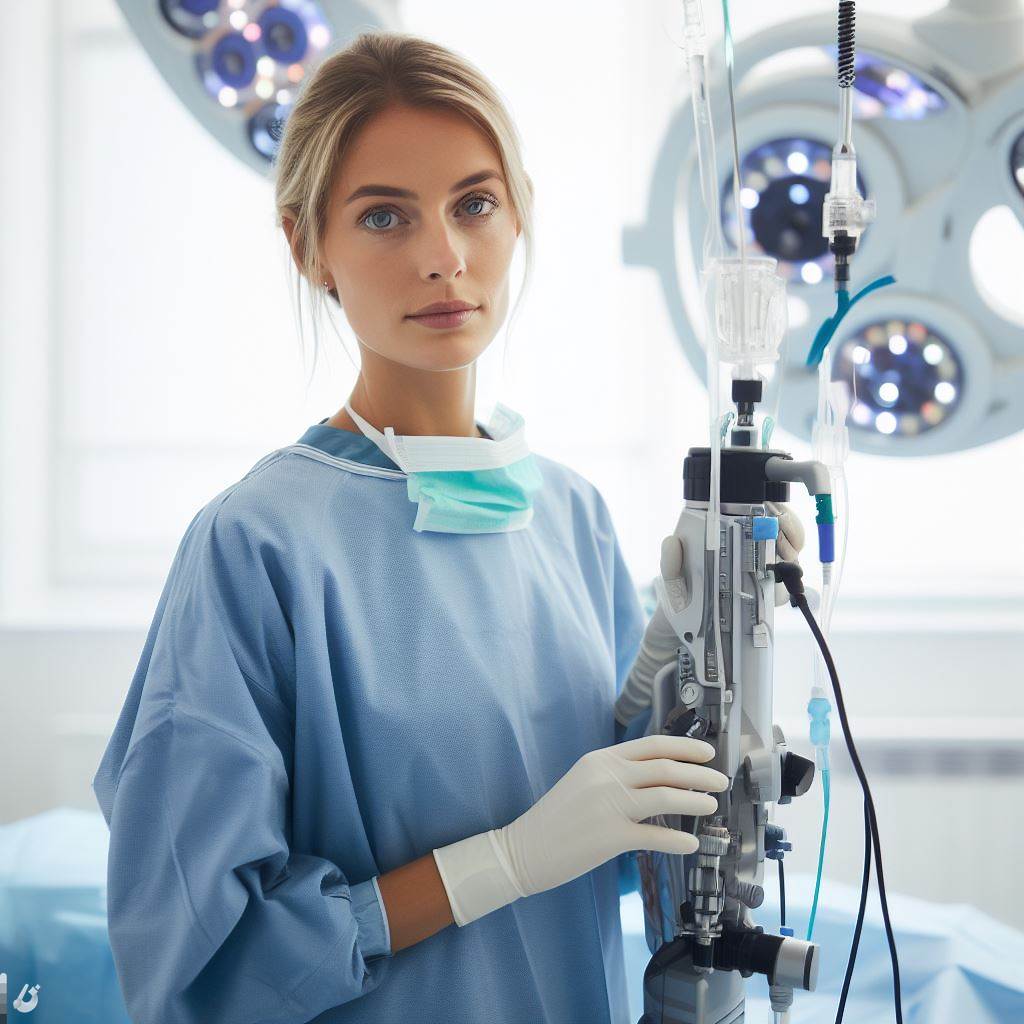Latest Surgical Technologies in UK Hospitals
Last Updated on January 27, 2024
Introduction
Surgical technologies play a pivotal role in UK hospitals by enabling precise and efficient medical interventions.
With constant advancements, these technologies have revolutionized the field of surgery.
It is undeniable that surgical technologies have significantly improved patient outcomes in UK hospitals.
These advancements have allowed for more accurate procedures, shorter recovery times, and reduced risk of complications.
One such advancement is the use of robotic-assisted surgery, which enables surgeons to perform complex procedures with enhanced precision.
This technology allows for smaller incisions, minimal scarring, and faster recovery periods.
In addition to robotics, new imaging technologies such as 3D visualization and augmented reality have transformed surgical practices.
Surgeons can now visualize anatomical structures in real-time, making procedures safer and more efficient.
Another area of constant development is the use of minimally invasive techniques.
These procedures, such as laparoscopy, offer patients reduced post-operative pain, decreased scarring, and a shorter hospital stay.
Furthermore, advancements in surgical instruments and equipment, such as laser scalpels and robotic surgical arms, have increased surgical precision, resulting in improved patient outcomes.
The integration of artificial intelligence and machine learning algorithms in surgical technologies has also shown promising results.
These technologies can analyze patient data, assist surgeons in decision-making, and improve surgical planning and outcomes.
The continuous advances in surgical technologies in UK hospitals have undoubtedly revolutionized the field of surgery.
Patients now have access to safer, less invasive, and more effective treatments, ultimately leading to a better quality of life.
Overview of Robotic-assisted Surgery
In recent years, there have been significant advancements in surgical technologies, particularly in the field of robotic-assisted surgery.
This innovative approach has revolutionized the way operations are performed in UK hospitals, offering numerous benefits in terms of precision and minimally invasive procedures.
In this blog section, we will explore the definition and explanation of robotic-assisted surgery, discuss its advantages, and highlight some specific robotic surgical systems used in UK hospitals.
Definition and Explanation of Robotic-assisted Surgery
Robotic-assisted surgery, also known as robot-assisted surgery or robotic surgery, is a state-of-the-art surgical technique that utilizes robotic systems to assist surgeons during operations.
It involves using robotic arms controlled by surgeons to perform precise and complex procedures with enhanced dexterity and flexibility.
Unlike traditional surgery, where the surgeon directly performs the procedure, robotic-assisted surgery allows the surgeon to operate through a console equipped with surgical controls and a high-definition monitor.
The robots replicate the surgeon’s hand movements with incredible precision, providing a magnified 3D view of the surgical site.
Benefits of Robotic-assisted Surgery
One of the major advantages of robotic-assisted surgery is its unmatched precision.
The robotic systems can make extremely precise movements, minimizing the risk of human error and resulting in better surgical outcomes.
This precision is particularly beneficial in delicate surgeries such as cardiac and neurosurgical procedures.
Additionally, robotic-assisted surgery offers the advantage of being minimally invasive.
The instruments used in robotic surgery are significantly smaller than those used in traditional surgery, resulting in smaller incisions.
This leads to reduced scarring, less post-operative pain, shorter hospital stays, and faster recovery times for patients.
Specific Robotic Surgical Systems Used in UK Hospitals
Several robotic surgical systems are currently utilized in UK hospitals to perform a variety of procedures. Some notable examples include:
- da Vinci Surgical System: The da Vinci system is one of the most well-known robotic surgical systems. It enables surgeons to perform complex surgeries with enhanced precision through small incisions.
- CyberKnife Robotic Radiosurgery System: This cutting-edge system is used in the treatment of tumors and other conditions requiring high-precision radiation therapy.
It delivers targeted radiation without the need for surgical incisions. - MAKOplasty: Primarily used in orthopedic surgeries, the MAKOplasty system assists surgeons in performing joint replacements with unparalleled accuracy and allows for faster recovery.
- Stereotaxis Robotic Magnetic Navigation System: This system combines robotics and magnetic fields to perform intricate cardiac procedures, reducing the need for open-heart surgery.
These are just a few examples of the robotic surgical systems being utilized in UK hospitals.
The widespread adoption of these technologies has revolutionized the surgical landscape, offering patients improved outcomes, reduced risks, and enhanced recovery.
Basically, robotic-assisted surgery has emerged as a game-changer in UK hospitals.
Its precision and minimally invasive nature have revolutionized the field of surgery, allowing for safer and more efficient procedures.
With the continued advancement of robotic surgical systems, the future looks promising for patients seeking high-quality surgical care.
Read: The Role of Nurses in UK Public Health
Advancements in Imaging Techniques
Imaging plays a crucial role in surgical procedures, providing surgeons with detailed visuals that guide their actions and decisions.
The latest imaging technologies used in UK hospitals have significantly improved surgical outcomes, revolutionizing the field.
Importance of Imaging in Surgical Procedures
Imaging techniques offer a non-invasive way to view internal organs, tissues, and structures, allowing surgeons to accurately diagnose and plan for surgeries.
These technologies provide a comprehensive understanding of the patient’s anatomy, ensuring precision during the procedure.
With imaging, surgeons can locate tumors, identify abnormalities, and assess the extent of damage, which enables them to make informed decisions on the best course of action.
It also helps in determining the most suitable surgical approach, reducing the risk of complications and improving patient safety.
Overview of the Latest Imaging Technologies
The UK hospitals employ state-of-the-art imaging technologies that have transformed the surgical landscape.
One such technology is Magnetic Resonance Imaging (MRI), which uses a strong magnetic field and radio waves to produce detailed images of the body’s internal structures.
MRI allows for precise visualization of soft tissues, such as the brain, muscles, and organs, making it invaluable in neurosurgery, orthopedics, and oncology.
The use of Computed Tomography (CT) scans is also widespread in UK hospitals.
CT imaging generates a series of cross-sectional X-ray images to create a 3D representation of the body.
It provides excellent visualization of bones, blood vessels, and organs, aiding surgeons in specialties such as cardiology, urology, and gastroenterology.
In addition to MRI and CT scans, UK hospitals have embraced 3D imaging technologies.
These advanced systems reconstruct a three-dimensional model from two-dimensional images, allowing surgeons to visualize the patient’s anatomy with remarkable clarity.
This aids in planning complex surgeries, such as reconstructive procedures and minimally invasive surgeries.
Benefits of Imaging Technologies in Improving Surgical Outcomes
The latest imaging technologies have revolutionized surgical procedures in several ways:
- Accurate Diagnosis: Imaging techniques provide detailed information, enabling precise diagnosis of pathologies and abnormalities.
- Enhanced Surgical Planning: Surgeons can analyze the images thoroughly, leading to better planning of surgical approaches and reducing potential risks.
- Precision Guidance: Real-time imaging during surgeries allows surgeons to navigate complex anatomical structures with precision.
- Minimally Invasive Surgeries: Imaging technologies play a crucial role in minimally invasive procedures, resulting in smaller incisions, reduced pain, and faster recovery for patients.
- Better Patient Outcomes: By providing a comprehensive understanding of each patient’s unique anatomy, surgical outcomes can be optimized, leading to improved patient satisfaction and reduced complications.
In short advancements in imaging technologies have transformed surgical procedures in UK hospitals.
MRI, CT scans, and 3D imaging offer detailed visualizations, aiding surgeons in accurate diagnosis, precise surgical planning, and improved patient outcomes.
The integration of these technologies into the surgical workflow has revolutionized the field, ushering in an era of enhanced safety, efficiency, and successful surgical outcomes.
Read: Mental Health Support for UK Nurses

Discover More: Challenges Facing New Surgeons in the UK
Innovative Surgical Instruments
The field of surgical instruments has witnessed significant advancements in recent years, particularly in UK hospitals.
These innovations have transformed surgical procedures and improved patient outcomes.
With the introduction of laparoscopic tools and laser devices, surgeons can now perform minimally invasive surgeries with increased precision and reduced risks.
Advancements in Surgical Instruments
- Laparoscopic Tools: Laparoscopy, also known as keyhole surgery, involves making small incisions through which a tiny camera and surgical tools are inserted.
This technique allows surgeons to operate with enhanced visualization and dexterity. - Laser Devices: Lasers have become indispensable in various surgical specialties.
They offer immense precision, minimize bleeding, and reduce the risk of damage to surrounding tissues. Laser technology has been particularly successful in ophthalmic and cosmetic surgeries. - Robot-Assisted Instruments: With the advent of robotics, surgeons can now perform complex procedures with greater accuracy.
Robot-assisted instruments provide enhanced maneuverability and allow surgeons to operate remotely, overcoming the limitations of traditional surgery.
These advancements have revolutionized surgical procedures by enabling surgeons to perform intricate operations through smaller incisions, resulting in reduced scarring, less pain, and faster recovery for patients.
Improved Surgical Procedures
The introduction of innovative surgical instruments has greatly improved surgical procedures in UK hospitals:
- Quick and Accurate Diagnosis: Advanced imaging and diagnostic tools help surgeons identify and locate abnormalities precisely, enabling better pre-operative planning.
- Minimally Invasive Surgeries: Laparoscopic tools and laser devices have made it possible to perform surgeries through minimal incisions, reducing the risk of infection and post-operative complications.
- Enhanced Precision: Innovative instruments allow surgeons to perform intricate procedures with utmost precision, minimizing the risk of errors and damage to vital structures.
- Reduced Blood Loss: Laser devices cauterize blood vessels during surgeries, minimizing bleeding and making procedures safer for patients.
- Quicker Recovery: Minimally invasive surgeries result in shorter hospital stays, faster recovery, and reduced post-operative pain, allowing patients to resume their daily activities sooner.
Examples of Innovative Surgical Instruments in UK Hospitals
UK hospitals have embraced several innovative surgical instruments to enhance patient care:
- da Vinci Surgical System: This robotic platform enables precise and minimally invasive surgeries across various specialties, including urology, gynecology, and general surgery.
- Harmonic Scalpel: This advanced surgical instrument uses ultrasonic vibrations to cut and coagulate tissues simultaneously, minimizing thermal damage and accelerating healing.
- EndoWrist Instruments: These robotic instruments replicate human wrist movements with increased dexterity, enabling surgeons to perform complex surgeries with enhanced precision.
- CO2 Laser: This laser device is widely used in dermatological and plastic surgeries, providing high precision and minimal scarring during tissue ablation.
These examples showcase the remarkable advancements in surgical instruments used in UK hospitals, demonstrating the commitment to providing safer and more effective surgical procedures for patients.
In essence, innovations in surgical instruments, such as laparoscopic tools, laser devices, and robotic systems, have significantly transformed surgical procedures in UK hospitals.
These advancements have ushered in an era of minimally invasive surgeries, improved precision, reduced complications, and faster recovery for patients.
The continuous development and adoption of innovative instruments contribute to enhancing the overall quality of healthcare in the UK.
Read: Famous Nurses in UK History: Their Legacies
Integration of Artificial Intelligence (AI)
The role of AI in surgical technologies
Artificial Intelligence (AI) is revolutionizing surgical technologies in UK hospitals by providing advanced capabilities and assisting medical professionals in various aspects of surgical planning and decision-making.
AI plays a crucial role in surgical technologies by enhancing the precision and accuracy of procedures.
With AI algorithms, surgeons can analyze vast amounts of medical data quickly and accurately, resulting in improved diagnostic capabilities.
How AI can assist in surgical planning and decision-making
In surgical planning, AI assists healthcare providers by analyzing medical images and identifying potential abnormalities, enabling surgeons to plan their procedures more effectively.
For instance, AI algorithms can detect tumors or other anomalies in medical images, allowing surgeons to determine the appropriate surgical approach for better patient outcomes.
Moreover, AI has the potential to significantly assist surgeons in decision-making during complex surgical procedures.
By analyzing real-time data such as patient vitals, blood flow, and tissue density, AI algorithms can provide real-time recommendations to surgeons, helping them make critical decisions swiftly and accurately.
Examples of AI applications in UK hospitals
There are several exciting examples of AI applications in UK hospitals that are revolutionizing surgical technologies.
One notable example is the use of machine learning algorithms to predict surgical outcomes based on patient demographics and medical history.
These algorithms analyze vast amounts of data from previous surgeries, enabling surgeons to anticipate potential complications and plan accordingly.
Another application of AI in surgical technologies is robot-assisted surgery.
AI-powered surgical robots can perform complex procedures with enhanced precision, reducing the risk of human error.
These robots can also provide real-time feedback to surgeons, ensuring optimal outcomes for patients.
In addition to surgical planning and decision-making, AI is also being utilized for post-surgical care.
AI algorithms can monitor patients’ recovery progress by analyzing vital signs and other health metrics.
This enables healthcare providers to detect complications early and intervene promptly, leading to better overall patient outcomes.
The integration of AI in surgical technologies is not without its challenges.
Ethical considerations, data privacy, and potential biases in algorithms are important factors that need to be addressed.
However, with proper regulations and continuous advancements in AI technology, these challenges can be overcome to harness the full potential of AI in improving surgical procedures.
In fact, the integration of Artificial Intelligence (AI) in surgical technologies has transformed the way surgeries are performed in UK hospitals.
AI provides invaluable assistance in surgical planning and decision-making, leading to improved patient outcomes.
With advancements in machine learning algorithms and robotics, AI continues to push the boundaries of surgical capabilities, revolutionizing the field of medicine.
Read: Nursing Internships in the UK: A Starter Guide
Delve into the Subject: Work-Life Balance for UK Health Admins
Find Out More: Challenges Faced by UK Paramedics Daily
Conclusion
Our exploration of the latest surgical technologies in UK hospitals, we’ve delved into a transformative landscape where innovation meets precision.
From robotic-assisted procedures, which amplify surgeons’ capabilities, to advanced imaging technologies providing unprecedented clarity, each advancement has been a cornerstone in redefining the surgical landscape.
The integration of these technologies extends beyond mere procedural enhancements.
It catalyzes quicker recovery periods, minimizes invasiveness, and ensures more personalized approaches to patient care.
Surgeons now navigate procedures with augmented reality, leveraging artificial intelligence for informed decision-making, ushering in an era of unparalleled accuracy.
The profound impact of these advancements on patient care cannot be overstated.
They represent not just technological tools but gateways to improved outcomes, reduced complications, and a redefined patient experience.
The synergy of surgical skill and state-of-the-art technology emerges as a beacon of hope, promising a paradigm shift in the healthcare landscape.
As these technologies become integral to the surgical narrative, we anticipate a future where precision and compassion harmonize, fostering a brighter era for healthcare in the UK.


